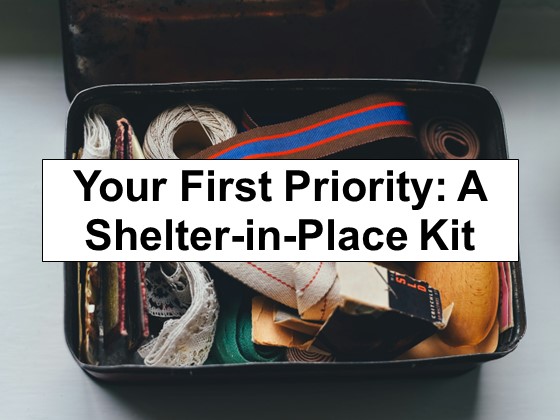Bug out kits (stuff for evacuation, usually on foot), everyday carry or EDC (survival gear you keep on your person) and, to a lesser extent, your vehicle kit (survival items in your vehicle) seem to be all that most preppers like to talk about. It’s often the first place that newbies focus on. But, as the video below discusses, none of these kits should be your first priority. Instead, you should be focusing on your shelter-in-place kit (gear and supplies for survival at home).
Why? Because you’re expected to spend more time at home, statistically speaking, than anywhere else … unless you’re obsessed with work or can’t stand your family. 😉 All kidding aside, bug out kits, vehicle kits, and EDC are important, but if you don’t have a quality shelter-in-place kit ready to go, you’re shortchanging your preparedness.
Sure, you could use your bug out bag gear or vehicle supplies when at home, but the idea isn’t quite the same. There are huge differences in ability (a quality off-grid stove for use at home is usually much easier/better than one for a backpack), quantity (you can store many more supplies in an at-home kit), and there’s the redundancy aspect of additional kits/supplies that you can rely upon if need be.
Watch the following video for ideas on how to put your shelter-in-place kit together properly. I’ll offer my comments below the video as I feel the need, and believe it or not, I have a lot to share on the topic. Enjoy!
CONTAINER: Any Rubbermaid container will suffice, but if you plan on storing these items where rodents may get into them, then consider something sturdier, such as a metal trash can or, at least, a latching tote bin.
FOOD: Freeze-dried meals are great, but they do require water to use and are expensive. Consider canned meals first, then add the fancy stuff.
LIGHTING: Solar lights are fine, but they’re not the best option, mainly because the sun doesn’t shine all the time. Get something with batteries, too. Lanterns are great, but don’t ignore a quality flashlight.
RADIO: I absolutely despise any hand-crank survival item. The idea seems neat, but it’s a waste of effort. Just buy a cheap, small AM/FM/Shortwave radio and stockpile plenty of batteries. And if you can get equipment that uses the same size batteries (i.e., all AA or all AAA) then that’s even better. I do agree with having an NOAA weather radio.
PHONE CHARGER: Yes! Have a portable charger or two in your kit. And include different cable types (e.g., USB-C, micro-USB, iphone) just in case you need them.
FIRST AID KIT: Most kits you can buy ready-made are crap. Make your own or buy from a truly reputable source. Make a note somewhere, maybe on your phone, to check and replace the contents yearly. Face masks are a good addition, too.
DUCT TAPE, PLASTIC SHEETING: These are always good to include, particularly for a chemical spill or biological hazard event. I would also add a few heavy-duty tarps for temporary home repairs, such as a broken window or hole in the roof.
TRASH BAGS: So many uses for these as well. Come to think of it, store your at-home supplies in a few 5-gallon buckets; they’ll double as a makeshift toilet and much more.
HAND SANITIZER: Sure, why not. But hand soap is better if you have water. Stock both.
GLOW STICKS. No. Just have a few quality flashlights and a lantern or two.
WATER: Absolutely! The more the merrier. 🙂
MAPS: Nah. Keep these in your bug out bags and vehicle kits. But it can’t hurt to have some maps on your phone, as I suggest in my smartphone apps book.
DECK OF CARDS: Yes. Any form of entertainment is good. If you’re going to include a deck of cards, you might consider a book of card games. Maybe a multigame set, too.
ADDITIONAL CONSIDERATIONS
I might also add something for warmth, such as extra clothing, socks, a stocking cap, etc. Maybe a small Mr. Buddy heater and some cannisters, but they’ll go quick. How about a sleeping bag? Maybe a battery-powered personal fan for the summer? I don’t recall seeing anything about disposable paper plates or bowls, or toilet paper, or anything that will help you conserve water, probably your most precious resource. I also don’t recall him mentioning prescription medications that you might need. What about pet supplies, including food and water? Granted, these bulkier items will grow the size of your kit quickly, but I’d say they’re important.
Ultimately, there’s a lot you can and should include. And, yes, it probably won’t all fit in a single bin or bucket. If you’re worried about space, clear out a coat closet, raise your bed and use under-the-bed containers, or stash your supplies in a piece of furniture that is probably only holding crap you don’t need.

Leave a Reply